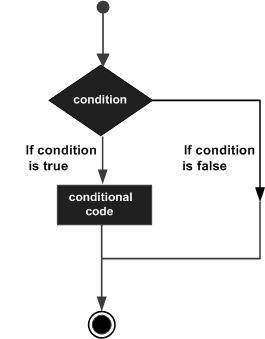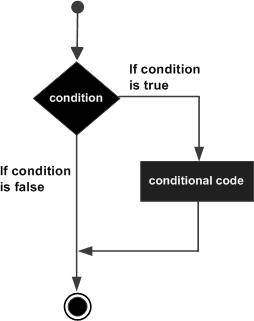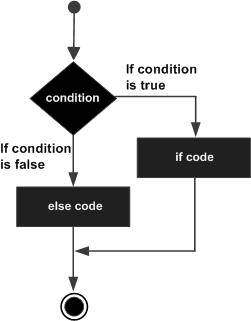Conditionals: Nested Statements

Note: Conditional statements also called Descicion making structures.
Decision making structures require that the programmer specify one or more conditions to be evaluated or tested by the program, along with a statement or statements to be executed if the condition is determined to be true, and optionally, other statements to be executed if the condition is determined to be false.
Following is the general from of a typical decision making structure found in most of the programming languages:

C++ programming language provides following types of decision making statements. Click the following links to check their detail.
| Statement | Description |
|---|---|
| if statement | An if statement consists of a boolean expression followed by one or more statements. |
| if...else statement | An if statement can be followed by an optional else statement, which executes when the boolean expression is false. |
| switch statement | A switch statement allows a variable to be tested for equality against a list of values. |
| nested if statements | You can use one if or else if statement inside another if or else if statement(s). |
| nested switch statements | You can use one swicth statement inside another switch statement(s). |
The ? : Operator:
We have covered conditional operator ? : in previous chapter which can be used to replace if...elsestatements. It has the following general form:
Exp1 ? Exp2 : Exp3;
Where Exp1, Exp2, and Exp3 are expressions. Notice the use and placement of the colon.
The value of a ? expression is determined like this: Exp1 is evaluated. If it is true, then Exp2 is evaluated and becomes the value of the entire ? expression. If Exp1 is false, then Exp3 is evaluated and its value becomes the value of the expression.
"If Statement Example"
An if statement consists of a boolean expression followed by one or more statements.
Syntax:
The syntax of an if statement in C++ is:
if(boolean_expression)
{
// statement(s) will execute if the boolean expression is true
}
If the boolean expression evaluates to true, then the block of code inside the if statement will be executed. If boolean expression evaluates to false, then the first set of code after the end of the if statement (after the closing curly brace) will be executed.
Flow Diagram:

Example:
#include <constream.h>
int main ()
{
// local variable declaration:
int a = 10;
// check the boolean condition
if( a < 20 )
{
// if condition is true then print the following
cout << "a is less than 20;" << endl;
}
cout << "value of a is : " << a << endl;
return 0;
}
When the above code is compiled and executed, it produces the following result:
a is less than 20; value of a is : 10
"If...else Statement Example"

An if statement can be followed by an optional else statement, which executes when the boolean expression is false.
Syntax:
The syntax of an if...else statement in C++ is:
if(boolean_expression) { // statement(s) will execute if the boolean expression is true } else { // statement(s) will execute if the boolean expression is false }
If the boolean expression evaluates to true, then the if block of code will be executed, otherwise else block of code will be executed.
Flow Diagram:

Example:
#include <constream.h> int main () { // local variable declaration: int a = 100; // check the boolean condition if( a < 20 ) { // if condition is true then print the following cout << "a is less than 20;" << endl; } else { // if condition is false then print the following cout << "a is not less than 20;" << endl; } cout << "value of a is : " << a << endl; return 0; }
When the above code is compiled and executed, it produces the following result:
a is not less than 20; value of a is : 100
The if...else if...else Statement:
An if statement can be followed by an optional else if...else statement, which is very usefull to test various conditions using single if...else if statement.
When using if , else if , else statements there are few points to keep in mind.
- An if can have zero or one else's and it must come after any else if's.
- An if can have zero to many else if's and they must come before the else.
- Once an else if succeeds, none of he remaining else if's or else's will be tested.
Syntax:
The syntax of an if...else if...else statement in C++ is:
if(boolean_expression 1) { // Executes when the boolean expression 1 is true } else if( boolean_expression 2) { // Executes when the boolean expression 2 is true } else if( boolean_expression 3) { // Executes when the boolean expression 3 is true } else { // executes when the none of the above condition is true. }
Example:
#include <constream.h> int main () { // local variable declaration: int a = 100; // check the boolean condition if( a == 10 ) { // if condition is true then print the following cout << "Value of a is 10" << endl; } else if( a == 20 ) { // if else if condition is true cout << "Value of a is 20" << endl; } else if( a == 30 ) { // if else if condition is true cout << "Value of a is 30" << endl; } else { // if none of the conditions is true cout << "Value of a is not matching" << endl; } cout << "Exact value of a is : " << a << endl; return 0; }
When the above code is compiled and executed, it produces the following result:
Value of a is not matching Exact value of a is : 100
"switch Statements Example"

A switch statement allows a variable to be tested for equality against a list of values. Each value is called a case, and the variable being switched on is checked for each case.
Syntax:
The syntax for a switch statement in C++ is as follows:
switch(expression){ case constant-expression : statement(s); break; //optional case constant-expression : statement(s); break; //optional // you can have any number of case statements. default : //Optional statement(s); }
The following rules apply to a switch statement:
- The expression used in a switch statement must have an integral or enumerated type, or be of a class type in which the class has a single conversion function to an integral or enumerated type.
- You can have any number of case statements within a switch. Each case is followed by the value to be compared to and a colon.
- The constant-expression for a case must be the same data type as the variable in the switch, and it must be a constant or a literal.
- When the variable being switched on is equal to a case, the statements following that case will execute until a break statement is reached.
- When a break statement is reached, the switch terminates, and the flow of control jumps to the next line following the switch statement.
- Not every case needs to contain a break. If no break appears, the flow of control will fall throughto subsequent cases until a break is reached.
- A switch statement can have an optional default case, which must appear at the end of the switch. The default case can be used for performing a task when none of the cases is true. No break is needed in the default case.
Flow Diagram:

Example:
#include <constream.h> int main () { // local variable declaration: char grade = 'D'; switch(grade) { case 'A' : cout << "Excellent!" << endl; break; case 'B' : case 'C' : cout << "Well done" << endl; break; case 'D' : cout << "You passed" << endl; break; case 'F' : cout << "Better try again" << endl; break; default : cout << "Invalid grade" << endl; } cout << "Your grade is " << grade << endl; return 0; }
This would produce the following result:
You passed Your grade is D
"Nested if Statements Example"
It is always legal to nest if-else statements, which means you can use one if or else if statement inside another if or else if statement(s).
Syntax:
The syntax for a nested if statement is as follows:
if( boolean_expression 1) { // Executes when the boolean expression 1 is true if(boolean_expression 2) { // Executes when the boolean expression 2 is true } }
You can nest else if...else in the similar way as you have nested if statement.
Example:
#include <constream.h> int main () { // local variable declaration: int a = 100; int b = 200; // check the boolean condition if( a == 100 ) { // if condition is true then check the following if( b == 200 ) { // if condition is true then print the following cout << "Value of a is 100 and b is 200" << endl; } } cout << "Exact value of a is : " << a << endl; cout << "Exact value of b is : " << b << endl; return 0; }
When the above code is compiled and executed, it produces the following result:
Value of a is 100 and b is 200 Exact value of a is : 100 Exact value of b is : 200
"Nested switch Statements Example"
It is possible to have a switch as part of the statement sequence of an outer switch. Even if the case constants of the inner and outer switch contain common values, no conflicts will arise.
C++ specifies that at least 256 levels of nesting be allowed for switch statements.
Syntax:
The syntax for a nested switch statement is as follows:
switch(ch1) {
case 'A':
cout << "This A is part of outer switch";
switch(ch2) {
case 'A':
cout << "This A is part of inner switch";
break;
case 'B': // ...
}
break;
case 'B': // ...
}
Example:
#include <constream.h>
int main ()
{
// local variable declaration:
int a = 100;
int b = 200;
switch(a) {
case 100:
cout << "This is part of outer switch" << endl;
switch(b) {
case 200:
cout << "This is part of inner switch" << endl;
}
}
cout << "Exact value of a is : " << a << endl;
cout << "Exact value of b is : " << b << endl;
return 0;
}
This would produce the following result:
This is part of outer switch This is part of inner switch Exact value of a is : 100 Exact value of b is : 200
"Conditional Operator '? :' Example"
Exp1 ? Exp2 : Exp3;
where Exp1, Exp2, and Exp3 are expressions. Notice the use and placement of the colon. The value of a ? expression is determined like this: Exp1 is evaluated. If it is true, then Exp2 is evaluated and becomes the value of the entire ? expression. If Exp1 is false, then Exp3 is evaluated and its value becomes the value of the expression.
The ? is called a ternary operator because it requires three operands and can be used to replace if-else statements, which have the following form:
if(condition){ var = X; }else{ var = Y; }
For example, consider the following code:
if(y < 10){ var = 30; }else{ var = 40; }
Above code can be rewritten like this:
var = (y < 10) ? 30 : 40;
Here, x is assigned the value of 30 if y is less than 10 and 40 if it is not. You can the try following example:
#include <constream.h> int main () { // Local variable declaration: int x, y = 10; x = (y < 10) ? 30 : 40; cout << "value of x: " << x << endl; return 0; }
When the above code is compiled and executed, it produces the following result:
value of x: 40


Thanks for sharing the knowledgeable stuff to enlighten us no words for this amazing blog.. learnt so many things I recommend everyone to learn something from this blogger and blog.. I am sharing it with others also
ReplyDeleteIT Software Training in Chennai | Python Training in Chennai | Dot Net Training in Chennai
Thank you so much for posting this hub, Nice work on the Dot net Training..
ReplyDeleteRegards,
https://www.softlogicsys.in/datascience-training-in-chennai/
https://www.softlogicsys.in/machine-learning-training-in-chennai/
https://www.softlogicsys.in/linux-training-in-chennai/
https://www.softlogicsys.in/dba-administration-training-in-chennai/